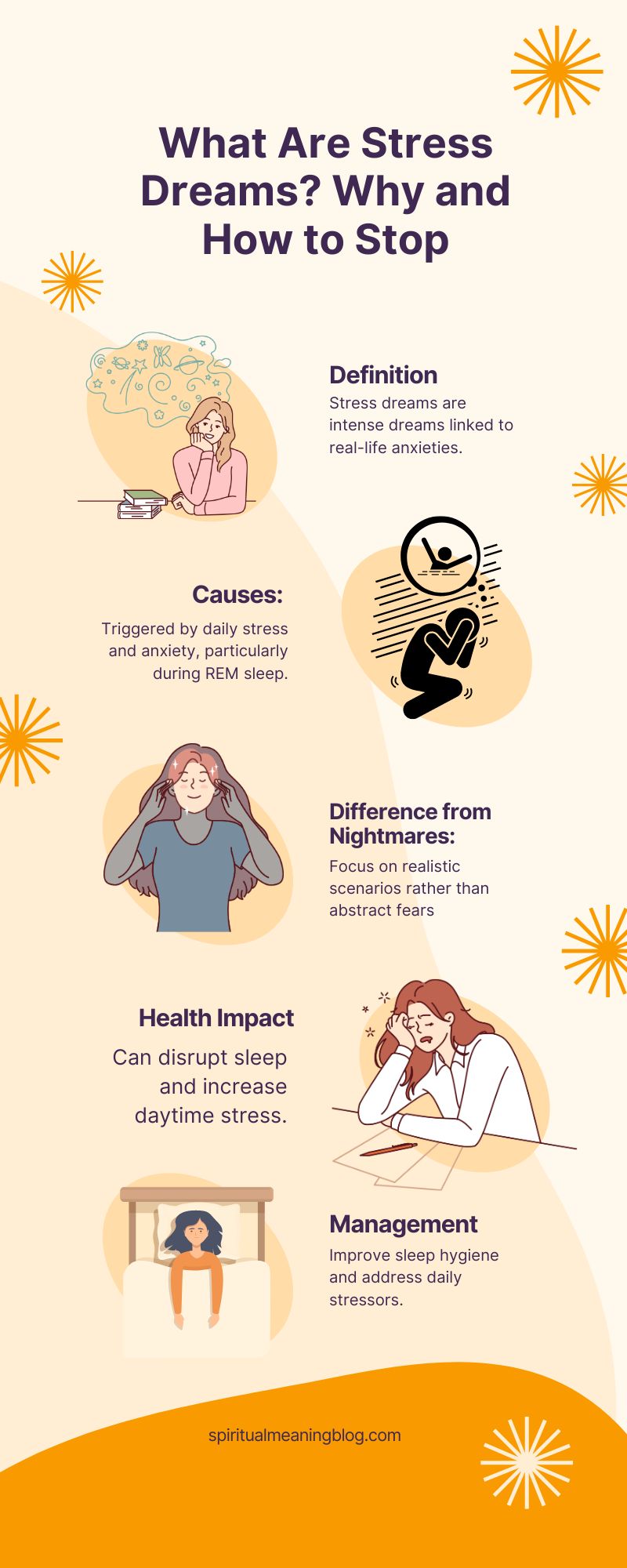Have you ever found yourself in a bizarre dream scenario, like showing up unprepared for an important meeting, or endlessly falling, only to wake up in a cold sweat? If so, you’ve likely had a stress dream.
Stress dreams, those unsettling dreams that leave you feeling anxious and overwhelmed, are more than just bad dreams. They are a mirror to our inner tensions, reflecting our anxieties and fears in a distorted, magnified way.
Ever wondered why your mind conjures up these stress dreams? They are not just random; they often have a root cause in our daily lives. From work pressure to personal issues, stress dreams pick up on these and turn them into vivid, sometimes bizarre, dream sequences.
The good news is, stress dreams can be managed. Understanding what triggers your stress dreams is the first step to controlling them. This article will delve into the world of stress dreams, shedding light on why they happen and offering tips to help you say goodbye to those restless nights.
Let’s embark on a journey to unravel the secrets of stress dreams and find ways to achieve peaceful, stress-free sleep.
What Is a Stress Dream

Stress dreams are unique sleep experiences that occur during the REM (Rapid Eye Movement) stage of sleep. This is the phase where your brain is highly active, almost as if you’re awake.
It’s during REM sleep that your dreams take on a vivid and often intense character, particularly following periods of stress or anxiety in your waking life.
It’s common for people to mix up stress dreams with nightmares, but they’re distinct in nature. While nightmares tend to be more intense and often feature frightening or horrific content, stress dreams typically revolve around everyday, more mundane anxieties.
These might include scenarios like arriving late for an important meeting, forgetting a crucial project deadline, or even being unprepared for an exam.
Unlike nightmares, stress dreams often mirror real-life worries and anxieties. They’re not necessarily terrifying in the traditional sense, but they can be deeply unsettling.
Stress dreams frequently focus on relatable, day-to-day stresses, making them resonate more with our conscious minds.
The impact of stress dreams can be significant. They might not terrify you in the way nightmares do, but they can certainly leave you feeling uneasy or anxious upon waking. In some cases, stress dreams are recurrent, which can lead to a cycle of anxiety and disrupted sleep.
You might find yourself waking up in the middle of the night, heart racing, with the remnants of the dream lingering in your mind, making it hard to fall back asleep and affecting your mood the next day.
Common Types of Stress Dreams and What They Might Mean
Stress dreams are not just random images; they often reflect our inner worries and anxieties. Delving into these dreams can provide insights into what’s troubling us in our waking lives. Here are some common types of stress dreams and their potential meanings:
Dream of Teeth Falling Out: A fascinating 2018 study linked dreams of teeth falling out to physiological stress. Such dreams are notably prevalent among individuals suffering from bruxism, or teeth grinding, a condition often associated with stress and anxiety.
These dreams might symbolize feelings of personal loss or significant life transitions, reflecting deep-seated fears about change and instability.
Dream of Being Chased: According to a 2010 study in the European archives of psychiatry and clinical neuroscience, dreams where one is being chased are common in the realm of stress dreams and nightmares.
These dreams might represent feelings of helplessness, fear, or vulnerability. They often mirror our real-life situations where we feel pressured or threatened, whether emotionally, professionally, or physically.
Dream of Trying to Find Lost Things: Ever dreamt of misplacing something crucial, like forgetting your pants or losing a pen before an important exam?
These dreams might be the brain’s way of rehearsing for potential mishaps or challenges. It’s a mental preparation for dealing with stress and unexpected situations, helping us stay resilient when things don’t go as planned.
Other recurring themes in stress dreams include scenarios like car troubles, experiencing the death of a loved one, infidelity, or being late for an important event. Neuroscientist Isabelle Arnulf points out that experiencing stress or anxiety dreams is entirely normal.
It’s a relief for many who fear that their stress dreams, like finding themselves unexpectedly naked in public, are out of the ordinary.
Understanding what triggers these dreams is crucial. They often stem from our day-to-day anxieties, fears, and stresses, manifesting in our subconscious as vivid, often unsettling dream sequences.
By addressing the underlying issues in our waking life, we might find a key to reducing the frequency or intensity of these stress dreams.
Why Do People Have Stress Dreams?

Stress dreams are a complex interplay between our daily experiences and our subconscious mind. Here’s an in-depth look at why they occur:
Daytime Experiences and Nighttime Dreams
Our brains are incredibly active during sleep, especially at night. They work tirelessly, processing and ‘flushing out’ our daily thoughts and emotions.
This means the stress and anxiety you experience during the day can often find their way into your dreams, taking on new forms and narratives.
High Stress and REM Sleep
Research has uncovered a fascinating link between stress levels and REM (Rapid Eye Movement) sleep – the stage where most dreaming happens. When you’re highly stressed, your body tends to spend more time in REM sleep.
This leads to more vivid, intense, and often stress-laden dreams. It’s a cyclical problem: more stress leads to more intense dreams, which can, in turn, contribute to increased stress by disrupting your sleep.
Cortisol and Sleep Quality
During periods of stress and anxiety, your body produces more cortisol, a hormone critical in managing stress. However, an increase in cortisol can fragment your sleep quality.
This disruption in sleep patterns can lead to particularly intense and memorable dreams, often laden with anxiety and stress.
The Vicious Cycle of Stress Dreams
Here’s the catch – stress dreams can exacerbate the very stress they reflect. They can prevent your body from fully recharging during sleep, leaving you more tired and stressed the next day. This can create a vicious cycle where stress leads to intense dreams, which then lead to more stress.
Factors That Contribute to Stress Dreams:
While stress is a primary driver of these dreams, certain factors can heighten their likelihood:
- Emotional Turmoil: Personal or professional challenges can amplify stress levels, making stress dreams more frequent.
- Life Changes: Major changes, such as moving, job transitions, or relationship shifts, can be stressful and often appear symbolically in dreams.
- Health Concerns: Worrying about health, whether your own or a loved one’s, can be a significant source of stress and often manifests in dreams.
- Global or Societal Stressors: Events like pandemics or economic downturns contribute to a collective sense of stress, which can influence the nature of your dreams.
In conclusion, stress dreams are a reflection of our inner world and the stresses we face in our daily lives. They are not merely disturbances in our sleep but rather significant indicators of our mental and emotional states. By understanding the factors that contribute to these dreams, we can start to address our stressors, leading to better sleep and overall well-being.
How To Stop Stress Dreams

Although completely stopping stress dreams might be challenging, there are effective ways to manage them for a better night’s sleep. Let’s explore a few strategies:
Create A Buffer Zone:
Importance of Wind-Down Time: After a day of constant activity and stress, it’s crucial to give your brain and body time to relax and prepare for sleep. This wind-down period, or buffer zone, helps transition from the day’s stresses to a restful night.
Activities to Include: About an hour before bed, engage in calming activities like taking a warm bath, reading a book, or practicing relaxation techniques like yoga or deep breathing. It’s also beneficial to turn off electronic devices during this time to reduce exposure to stimulating blue light.
Schedule Worry Time:
Constructive Worrying: This involves setting aside a specific time earlier in the evening to process your worries and concerns, rather than carrying them to bed with you.
How to Practice: Find a quiet spot and spend 15 to 30 minutes writing down your anxieties. On one side of a piece of paper, list your worries. On the other side, jot down possible solutions or steps to address these concerns. This process can help clear your mind before sleep.
Embrace Curiosity:
Journaling Your Dreams: Keeping a dream journal to record details of your stress dreams can be insightful. Write down as much as you remember upon waking.
Analyzing Dream Content: Look for patterns or recurring themes in your dreams. This can help you identify potential triggers in your waking life. Understanding these connections may not only reduce the frequency of stress dreams but also enhance your creativity and problem-solving abilities.
Improve Your Sleep Hygiene
Consistent Sleep Schedule: Regular sleep and wake times are crucial. They help reinforce your body’s internal clock, making it easier to fall asleep and wake up feeling refreshed.
Limit Exposure to Blue Light: Electronic devices like laptops and phones emit blue light, which can disrupt the production of melatonin, the sleep hormone, and increase cortisol levels. This disruption can hinder your ability to fall asleep and potentially lead to stress dreams. Try to switch off these devices at least an hour before bed.
Optimize Your Sleep Environment: Make your bedroom a haven for sleep. Keep it quiet, dark, and cool. Invest in comfortable bedding and consider using blackout curtains or white noise machines if needed.
Watch Your Caffeine Intake: Caffeine can linger in your system for several hours and disrupt your sleep patterns. Try to limit caffeine consumption to the morning and avoid it in the afternoon and evening.
Discourage Daytime Napping: While napping can be rejuvenating, it can also interfere with your nighttime sleep. If you need to nap, keep it short – about 20 to 30 minutes.
Exercise Regularly
Benefits of Exercise: Daily physical activity can greatly improve sleep quality and overall health. Regular exercise reduces the risk of diseases and can also alleviate symptoms of anxiety and depression, contributing to better sleep.
Types of Beneficial Exercise:
Aerobic Exercises: Activities like swimming, biking, walking, or jogging are excellent for promoting healthy sleep.
Cardio Workouts: These can lead to deeper, more restful sleep.
Resistance Training: Activities like sit-ups and weight lifting not only build muscle but also enhance sleep quality.
Breathing Exercises: Practicing deep breathing can help lower blood pressure and relax your body before sleep.
Timing Your Workouts: While exercise is beneficial, it’s best to avoid vigorous activity close to bedtime. High-energy exercises can elevate your body temperature and energy levels, making it harder to fall asleep. Instead, opt for calming activities like yoga or gentle stretching in the evening.


